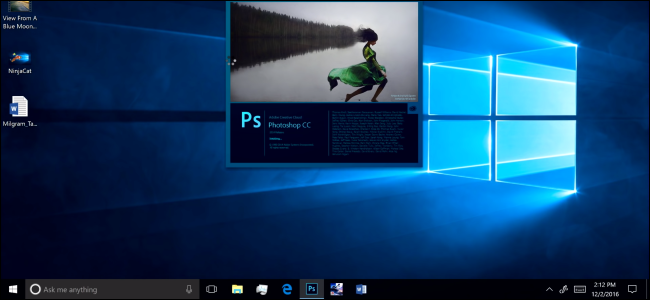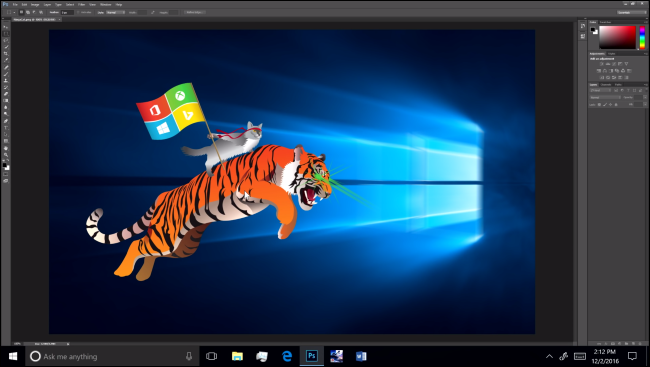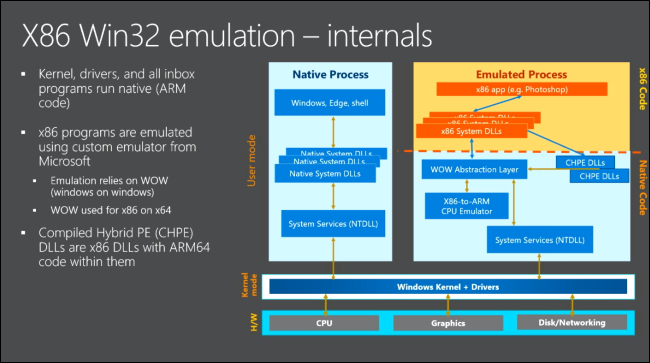Quick Links
Microsoft just launched a version of Windows 10 that will run on low-powered ARM hardware. Unlike Windows RT, the version of Windows 8 that powered the original Surface and Surface 2, this is a full version of Windows 10 with an emulation layer that allows it to run traditional desktop apps from outside the Windows Store.
Why Is Microsoft Putting Windows 10 on ARM?
ARM is a different type of processor architecture from the standard Intel x86 and 64-bit Intel architecture used on PCs today. (Even AMD produces chips that are compatible with Intel's architecture.) Mobile devices like the iPhone, iPad, and Android phones---along with many other smaller devices---have ARM chips instead of Intel chips inside them.
Low-powered ARM PCs have some advantages over traditional x86 ones (which are most of the desktops and laptops we use today). ARM PCs have built-in LTE cellular connectivity, often offer better battery life than Intel and AMD CPUs, and the hardware is less expensive for manufacturers.
Microsoft would like Windows 10 to run on ARM hardware so it can reap those benefits. Sure, you probably won't use an ARM desktop any time soon, but ARM could be a great choice for tablets, 2-in-1 convertibles, and even smaller laptops.
Rather than creating a more limited version of Windows for this platform, like they did with the failed Windows RT, Microsoft has decided to release a full version of Windows 10 for ARM hardware, one that can even run traditional Windows desktop applications.
The resulting devices are designed to be "Always Connected" and promise up to 20 hours of active use and 700 hours of "Connected Modern Standby". And they can even run traditional Windows desktop software.
Microsoft first announced a partnership with Qualcomm to create Windows on ARM at WinHEC in December, 2016.
It Can Run x86 Desktop Programs
This isn't just Windows RT all over again. Windows RT didn't allow you to run traditional desktop software. It even blocked developers from compiling their desktop applications for ARM processors and offering them to users. Windows RT only allowed apps from the Windows 8 Store.
Windows 10 on ARM is completely different. This is the full Windows desktop experience. Microsoft has created a special emulator layer that allows traditional 32-bit desktop applications to run on ARM processors, so everything should "just work". Microsoft even showed off a version of Windows 10 Professional on ARM, and said it supports all the usual advanced features you'd find on Windows 10 Professional.
The emulation works completely transparently to both users and the programs they run. It uses the same WOW (Windows on Windows) technology that Windows uses to run 32-bit applications on 64-bit versions of Windows today. However, the x86-to-ARM emulation happens entirely in software.
That software emulation could be an issue, however. While Microsoft demonstrated Windows 10 on ARM running the desktop version of Photoshop, saying that it "runs perfectly" on the Qualcomm processor, there's almost certain to be some slowdown in demanding desktop applications compared to running them on an Intel or AMD system. We'll have to wait to see performance benchmarks when Windows 10 on ARM is released.
Don't get distracted by the emulator, however. This isn't just an emulated Windows 10 operating system. The Windows kernel, hardware drivers, and all programs included with Windows are native ARM code. Universal Windows Platform (UWP) apps from the Windows Store are also native ARM programs. The emulator is only used when running traditional x86 Windows desktop software.
Much of this information comes from a video Microsoft released during BUILD 2017.
Support for Older Hardware Devices May Be a Problem
While Windows 10 on ARM can emulate traditional desktop applications, it won't be able to install hardware drivers written for traditional x86 or x64 Windows operating systems. It will need ARM versions of those hardware drivers to support different hardware devices.
Microsoft promises that Windows 10 on ARM "will have great device support for USB peripherals using the in-box class drivers". That's great for modern USB peripherals. But read between the lines: Devices that aren't supported by the built-in drivers won't work. Printer utilities and other hardware driver utilities may not work, either. This could be an issue for older or more obscure hardware peripherals.
These Devices Will Ship With Windows 10 S
It doesn't matter which type of CPU Windows is running on. You get a full Windows desktop experience with Windows 10 Home or Windows 10 Professional, even if you're using Windows 10 on ARM.
However, these Windows 10 on ARM devices will ship with Windows 10 S, just like Microsoft's Surface Laptop. Windows 10 S is a more limited edition of Windows 10 that can only run software from the Windows Store. However, you can pay to upgrade to Windows 10 Pro and get the ability to install desktop apps, just as you can with Windows 10 S on Intel and AMD PCs. Until September 2018, the upgrade from Windows 10 S to Windows 10 Pro will be free.
In other words, with Windows 10, ARM is just another hardware platform that's treated the same---it just needs an emulation layer to make that possible. Windows 10 S is a limited version of Windows that can run on any hardware platform.
When Will It Be Released?
The first Windows 10 on ARM device will be the Asus NovoGo, which will shop before the end of 2017. Most of these ARM-based devices, such as the HP Envy x2 with a Qualcomm Snapdragon 835 processor, will be available in Spring 2018.



